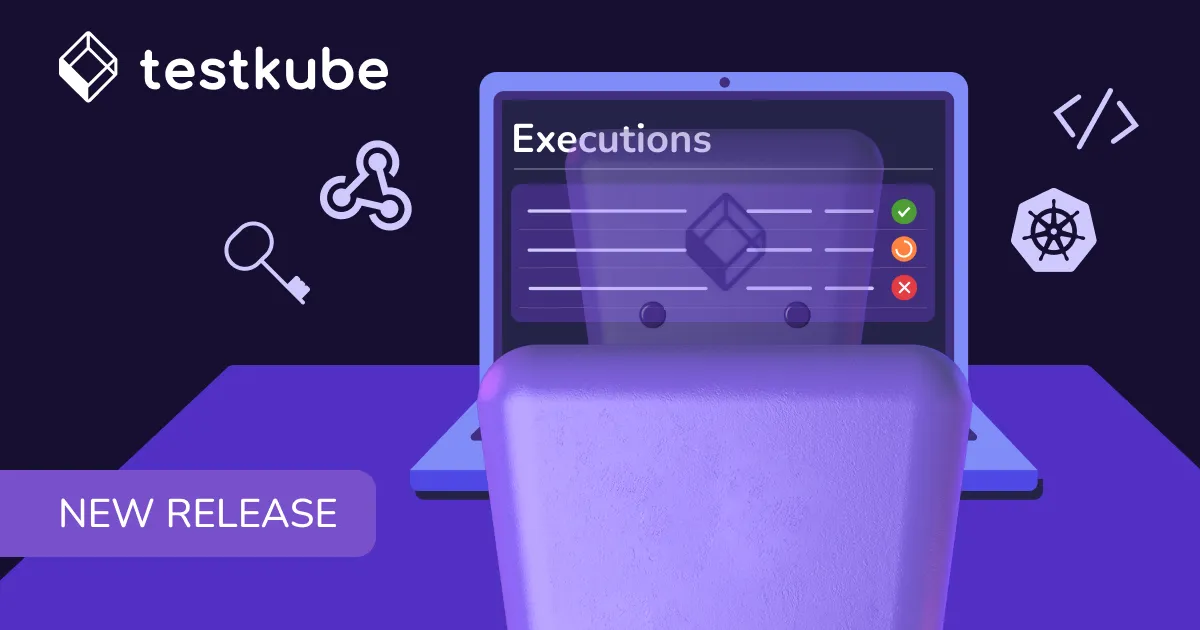

Table of Contents
Try Testkube instantly in our sandbox. No setup needed.
Try Testkube instantly in our sandbox. No setup needed.




Table of Contents
Executive Summary
Introduction to Parallel Testing
Testing becomes crucial as the complexity and the adoption of a solution grows. In Kubecon NA 2020, Jian from Airbnb talked about 10 more weird ways to blow up your Kubernetes. The first key takeaway from the talk was to test the new features on test clusters. But how does one ensure adequate testing without adding significant time to build or deploy pipelines?
To do so, here are two preliminary tests that have to be performed by a team before moving their solution to a production environment:
- The solution must be running on such systems that can support peak usage. This would require simulating many users to test the peak performance.
- Each feature of the solution has the expected behavior and is seamless to use. For this, testing has to be done across multiple environments, different browsers, devices, operating systems, and inputs, which means running tests across multiple configurations to ensure comprehensive coverage.
Testing for both of these scenarios ultimately requires time and resources, which is where parallel testing is a powerful approach to ensuring your system is tested at scale before it goes into production. Parallel testing works by executing tests simultaneously across different environments, allowing teams to save time and optimize resource utilization.
In this post, we will understand the concept of test parallelization and some of the common approaches like load and functional parallelization. We will discuss in depth some of the challenges associated with those approaches, and explore a Kubernetes native testing framework that can help us address those challenges, including how parallel testing enables teams to run tests efficiently across various setups.
What is Parallel Testing?
Parallel testing is a software testing technique that enables development teams to execute multiple tests simultaneously, significantly reducing overall testing time and boosting testing efficiency. Instead of running one test after another, parallel testing allows multiple test cases or entire test suites to be performed at the same time, making optimal use of available computing resources. This approach is especially valuable when testing across different operating systems, browser configurations, and multiple devices, ensuring that your application works seamlessly in a variety of environments.
By leveraging parallel testing, teams can run functional tests, regression tests, and performance tests concurrently, which accelerates feedback cycles and supports faster development iterations. Whether you’re validating new features or ensuring stability across platforms, parallel testing empowers teams to perform more tests in less time, ultimately enhancing the quality and reliability of your software.
Benefits of Parallel Testing
The benefits of parallel testing are substantial for any organization aiming to deliver high-quality software quickly and efficiently. By running multiple tests in parallel, teams can dramatically accelerate test execution, reducing the time required to validate new features or releases. This speed translates directly into faster release cycles and a shorter time-to-market, giving your team a competitive edge.
Parallel testing also improves test coverage by enabling the execution of more tests, including different scenarios, configurations, and edge cases, all within the same testing window. This comprehensive approach helps uncover issues that might be missed with traditional methods. Additionally, the benefits of parallel testing extend to cost efficiency—by maximizing the use of existing infrastructure and minimizing idle resources, organizations can achieve more with less, reducing the overall costs associated with testing. Ultimately, parallel testing helps teams deliver robust, reliable software while optimizing both time and resources.
Comparison with Sequential Testing
Sequential testing, often referred to as traditional sequential testing, involves running tests one after another, where each test must finish before the next begins. While this approach is straightforward to implement, it can lead to longer testing times and slower feedback, especially as the number of tests grows.
In contrast, parallel testing allows multiple tests to be executed simultaneously, significantly improving testing efficiency and reducing the overall time required for test execution. This means that development teams can run more tests in less time, accelerating the delivery of new features and updates. However, implementing parallel testing requires careful planning, as it introduces complexities such as test synchronization and data management to ensure that tests do not interfere with each other. Despite these challenges, the speed, coverage, and cost efficiency gained from running tests in parallel make parallel testing a powerful alternative to sequential testing for modern software development.
Parallel Testing Overview
Parallel Testing is the process of performing parallel simulations and tests to validate the functionality and performance of the application under test. Parallelization is done to both scale the performance under load, and perform functional analysis of the system under test to increase coverage and decrease overall test execution times. Parallel testing enables multiple test executions to occur simultaneously, improving efficiency and test coverage. Resource sharing among test environments or hardware can optimize performance and reduce costs in parallel testing setups. It is important to manage resource constraints when planning parallel testing to ensure optimal use of available resources. Teams can perform tests concurrently to maximize efficiency. Let us understand load and functional parallelization in detail.
Parallel Load Test Execution
To test a solution for peak-hour performance, creating a load by sending multiple requests from a few anonymous users is not enough. We are required to simulate a real-time environment by generating a massive load from named users from multiple geographies, possibly across multiple browsers or devices. Using multiple machines and virtual machines as part of the test infrastructure enables distributed load generation and more realistic simulations by providing scalable, isolated environments for testing.
Parallel load testing is the process of using parallel instances of load-testing tools to simulate a massive number of users from multiple nodes, possibly distributed across geographic locations. These tools can execute multiple test cases and coordinate different test parts across distributed systems, ensuring comprehensive load testing and efficient coverage. Solutions that face large volumes of concurrent users, such as social media platforms, banking applications, e-commerce websites, online gaming applications, etc. can all benefit from this approach to testing to ensure uninterrupted services for their users even under peak usage.
Enabling load parallelization has some challenges, let us understand these.
Challenges with Load Parallelization
- Generate Heavy Load: Load parallelization requires sending huge traffic to the software or application possibly from various geographical locations to test peak-hour performance and network latency. For example, for an online gaming website, we need to test if players from across geographies are playing in a multiplayer mode, they do not experience network lagging.
- Parameterized Virtual Users: To simulate specific user behavior by specifying individual characteristics, parameterized virtual users are required. Generating anonymous virtual user requests will not help if we need to customize test cases. Suppose in an online gaming website, players are chatting using the chat message feature in the game, it needs to be tested that their profile details are correct. Well-structured test code and test scripts are essential for accurately simulating user behavior in parallel load testing.
- Visualizing Results: We need real-time visualization of the test to simply understand the behavior of the application or the scenario that is causing the issue. It may also require aggregating such results to observe the behavior. For example, if the test shows large network latency when a massive load is created from multiple geographies, we need detailed results to visualize the issue and debug the underlying network infrastructure.
- Monitoring Test System: For the target system under test, monitoring can help us identify the resource usage such as CPU or memory utilization, and scalability behavior and anticipate performance issues when a massive load is introduced to the solution. For example, if the test shows a spike in CPU usage during peak hours then this analysis can be used to optimize the resource allocation.
Automated tests can be leveraged to efficiently generate and manage large-scale load scenarios in parallel testing environments. By integrating automated tests with well-organized test scripts and test code, teams can improve scalability and resource utilization during parallel load testing.
Parallel Functional Testing
Parallel functional testing is the process of performing parallel functional tests to increase test coverage and decrease overall test execution time. Automation testing and automated testing frameworks, such as Selenium and TestNG, play a crucial role in enabling efficient parallel execution by allowing multiple tests to run simultaneously across different environments. It is commonly paired with parameterized test execution by giving a specific input and checking to get the expected output. For example, using the browser version as input, we can test a feature across multiple browsers or operating systems in parallel and at the same time. A well-organized test suite and properly designed test scripts make it easier to facilitate parallel execution and manage test dependencies, ensuring reliable and efficient testing. This would not only help us with time to market but would also allow efficient testing and optimized usage of resources. Implementing parallel testing strategies is essential to optimize test times and improve overall workflow efficiency. In the coming section, we are going to talk about the need for functional parallelization with the help of an example.
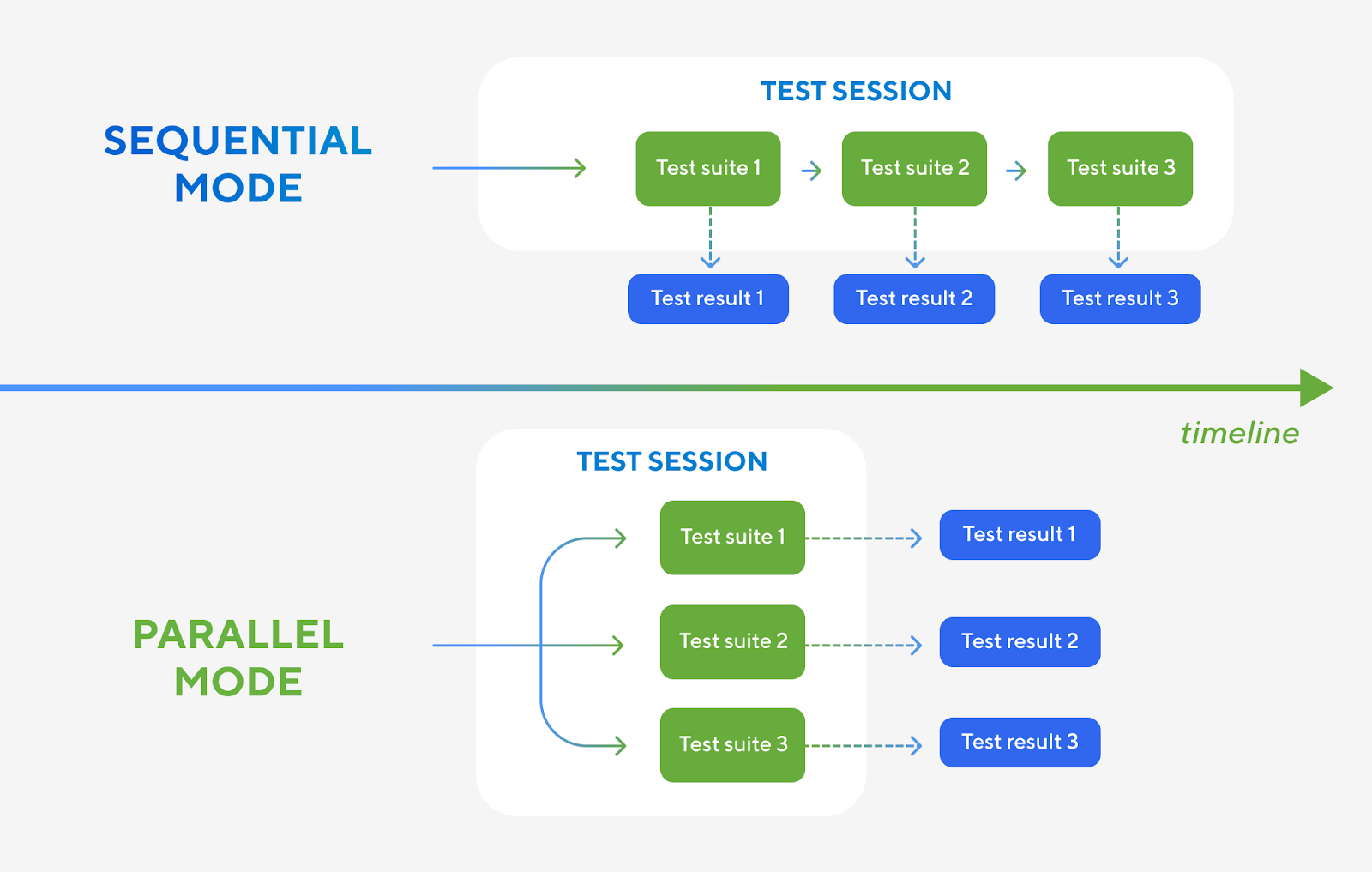
Why is Functional Parallelization Needed?
For example, we have a banking solution for which we want to make two-factor authentication mandatory for all users at the time of sign-in. Now testing this functionality across multiple browsers sequentially would not only take a lot of time but also resources. Here the input would be a parameterized user for which the two-factor authentication is enabled and happens successfully in a minimal amount of time. To ensure efficient parallel testing, it is important to create atomic tests and autonomous tests so that each test can run independently without interference from other tests. Additionally, it is essential to create tests specifically designed for parallel execution and to strategically select other tests that maximize coverage and efficiency.
With functional parallelization, we can test this functionality with various inputs across multiple browsers at the same time. Suppose the test fails for any of the browsers, we would get to know in a lot less time and work on identifying the root cause along with its solution.
Enabling functional parallelization also has some challenges, let us understand these.
Challenges with Functional Parallelization
- Test Isolation: Each test may have its own set of dependencies, configurations, and compatibility considerations. Setting up and configuring multiple test environments for different tests can be time-consuming and complex, especially when ensuring consistency across environments.
- Recording Results: In the previous example, we would require a system that can record different input cases and the combination browser and the actual results. These recorded results would then be used to compare with the expected result to determine the performance of functionality.
- Resource Allocation: Identifying which functionality test would require more resources and then distributing the resources accordingly could be a challenging task. Suppose for a banking solution, the sign-in and transaction functionalities have to be tested. Now these tests take time even though run in parallel so we need to determine the resource utilization limit for each. Key factors that influence parallel testing efficiency include test independence, resource availability, and environment consistency. Understanding these key factors is essential to optimize the number of parallel test executions and improve overall test suite performance.
Seeing the challenges associated with load and functional parallelization, we need a testing solution that automates testing with parameterized virtual users or other inputs across multiple browsers or operating systems simultaneously. Also, the solution should allow dynamic resource allocation based on test requirements and optimize resource utilization. For systems under test, the testing solution should provide real-time visualization of tests and aggregated results to perform result analysis.
Managing Test Data for Parallel Execution
Effective management of test data is essential when performing parallel testing, as multiple tests may need to access or modify the same data at the same time. Without proper strategies, this can lead to inconsistent test results or data corruption. To ensure reliable and accurate test execution, teams should isolate test data for each parallel test run—this can be achieved by using separate databases, unique datasets, or data cloning techniques for each parallel test execution.
Additionally, implementing data synchronization mechanisms helps maintain consistency across multiple tests, especially when tests require the same data or interact with shared resources. By prioritizing robust test data management, teams can safeguard the integrity of their parallel testing efforts, ensuring that test results are trustworthy and that the testing process remains efficient and reliable.
Handling Inter-Dependent Tests
Inter-dependent tests—where one test relies on the outcome or state of another—can complicate parallel testing efforts. Running such tests simultaneously without coordination can lead to unreliable test results or failures due to unexpected interactions. To address this, teams can implement test synchronization strategies, ensuring that dependent tests are executed in the correct order even within a parallel testing framework.
Alternatively, redesigning tests to be independent and self-contained—so that each test can run autonomously without relying on the results of another—can eliminate the need for synchronization altogether. By effectively handling inter-dependent tests, teams can maximize the efficiency and reliability of parallel testing, ensuring that test results remain accurate and that the overall testing process is robust and scalable.
Parallel Testing with Testkube
Testkube recently introduced Test Workflows, which leverages an execution and orchestration engine specifically built for executing any testing tools and scripts at scale, and since Testkube leverages Kubernetes as its runtime environment for test execution, it can scale and allocate resources for test execution in line with corresponding functionality provided by Kubernetes itself. Testkube enables a parallel testing approach by allowing teams to perform parallel testing work efficiently, executing multiple automated tests simultaneously to reduce overall testing time and optimize resource utilization.
Test Workflows are defined using a dedicated YAML vocabulary, and can be created using both extensive Wizards and samples for different scenarios which can then be further enhanced in any way required to fulfill your testing requirements using the Testkube Workflow Editor. Workflows also give fine-grained control over resource-usage and allocation for your tests, helping you maximize the utilization of your infrastructure for test execution, including the ability to run parallel tests and perform parallel testing across different tools and environments.
Parallel testing is one of the many functionalities available via Workflows:
- A parallel keyword makes it possible to run any testing tool across multiple nodes, enabling you to run parallel tests and perform parallel testing efficiently.
- A shard keyword makes it possible to shard tests across multiple nodes to ensure each node is running the right set of tests
- A matrix keyword makes it possible to parameterize tests running both in sequence and in parallel, supporting a robust parallel testing approach.
- A service keyword makes it possible to manage depending services to run distributed tests (for example with JMeter or Selenium)
- An execute keyword makes it possible to orchestrate multiple tests to run both in sequence and/or in parallel, allowing you to simulate more advanced usage scenarios - see our article on System Testing.
Workflows for Load Parallelization
As described above, running a load test from multiple nodes in parallel is often required to simulate large amounts of user traffic. Distributed testing enables the simultaneous execution of tests run across various nodes, allowing for comprehensive coverage and simulating real-world scenarios more effectively. The parallel keyword in Test Workflows allows you to parallelize any load-testing tool or script for this purpose, for example:
- K6 - parallel can be used to distribute and parameterize k6 scripts far beyond what can be achieved with the k6-operator
- JMeter - service can in combination with service.count be used to spawn any desired number of distributed worker nodes which are then invoked from a master node for running the test.
Artillery, Gatling - similar to K6, distributing and parameterizing Artillery and Gatling tests is easily achievable using the parallel keyword
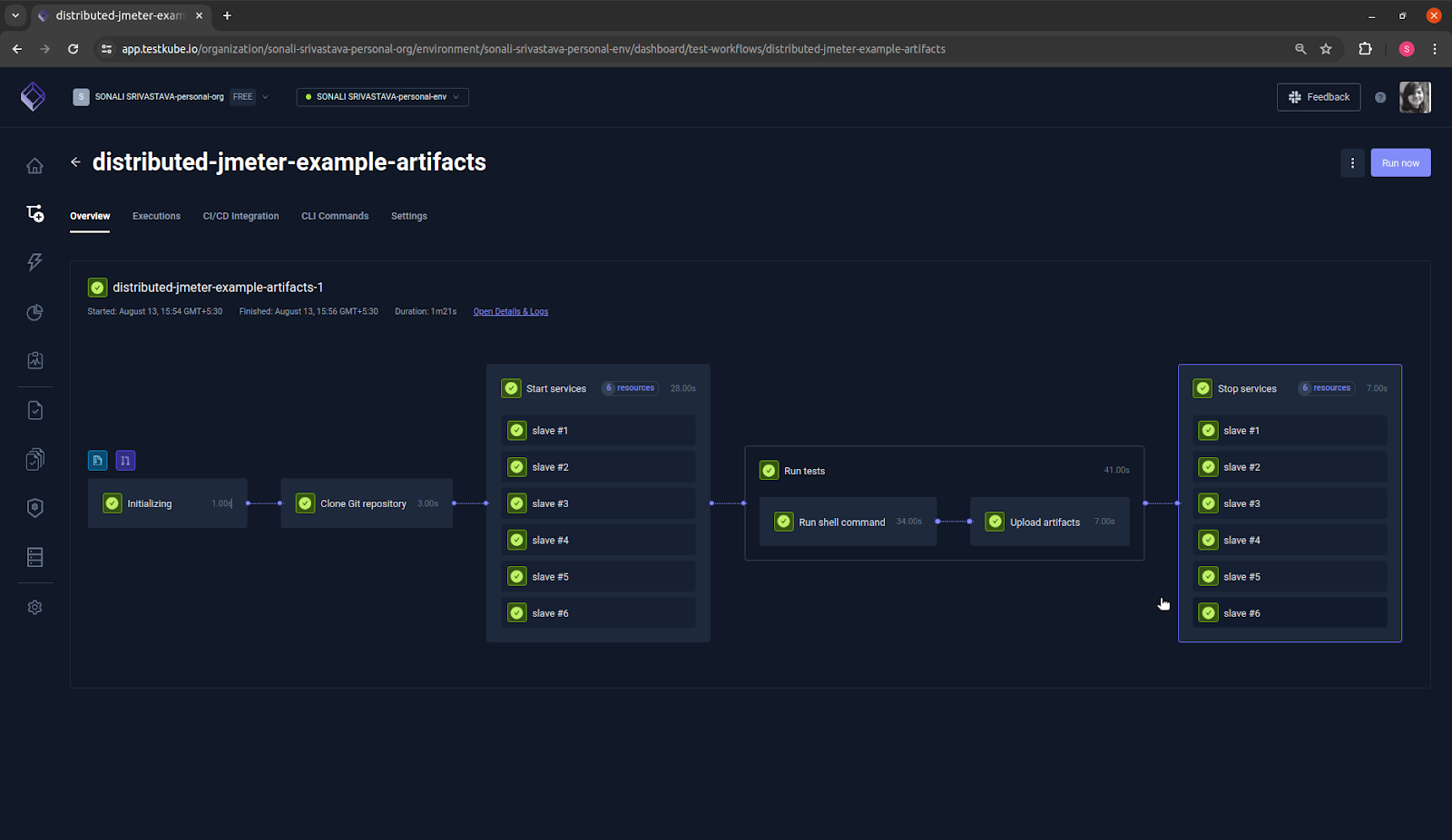
Examples for distributed load-testing with several of these tools are available in the Testkube Documentation.
Workflows for Functional/End-to-End Parallelization
Parallelizing functional and end-to-end (E2E) tests for the purpose of increased test coverage and reduced overall test execution times is equally well supported by the parallel keyword. Depending on the testing tool you are distributing, you can also shard test files or input parameters across nodes, which is supported by the shard keyword, for example
- Playwright tests can be parallelized and sharded across multiple nodes using Playwrights built-in sharding functionality
- Cypress tests can be parallelized and the Workflow Express Language can be used to shard test files accordingly
- API Testing tools like Postman and SoapUI can be parallelized and parameterized similarly to increase test coverage for APIs
- Acceptance testing tools like Selenium and Robot-Framework can be parallelized and parameterized for different browsers and user input, increasing acceptance-test coverage before releasing applications into production.
- Any other testing tool or script can be distributed across multiple nodes, with parameterization as applicable for each tool.
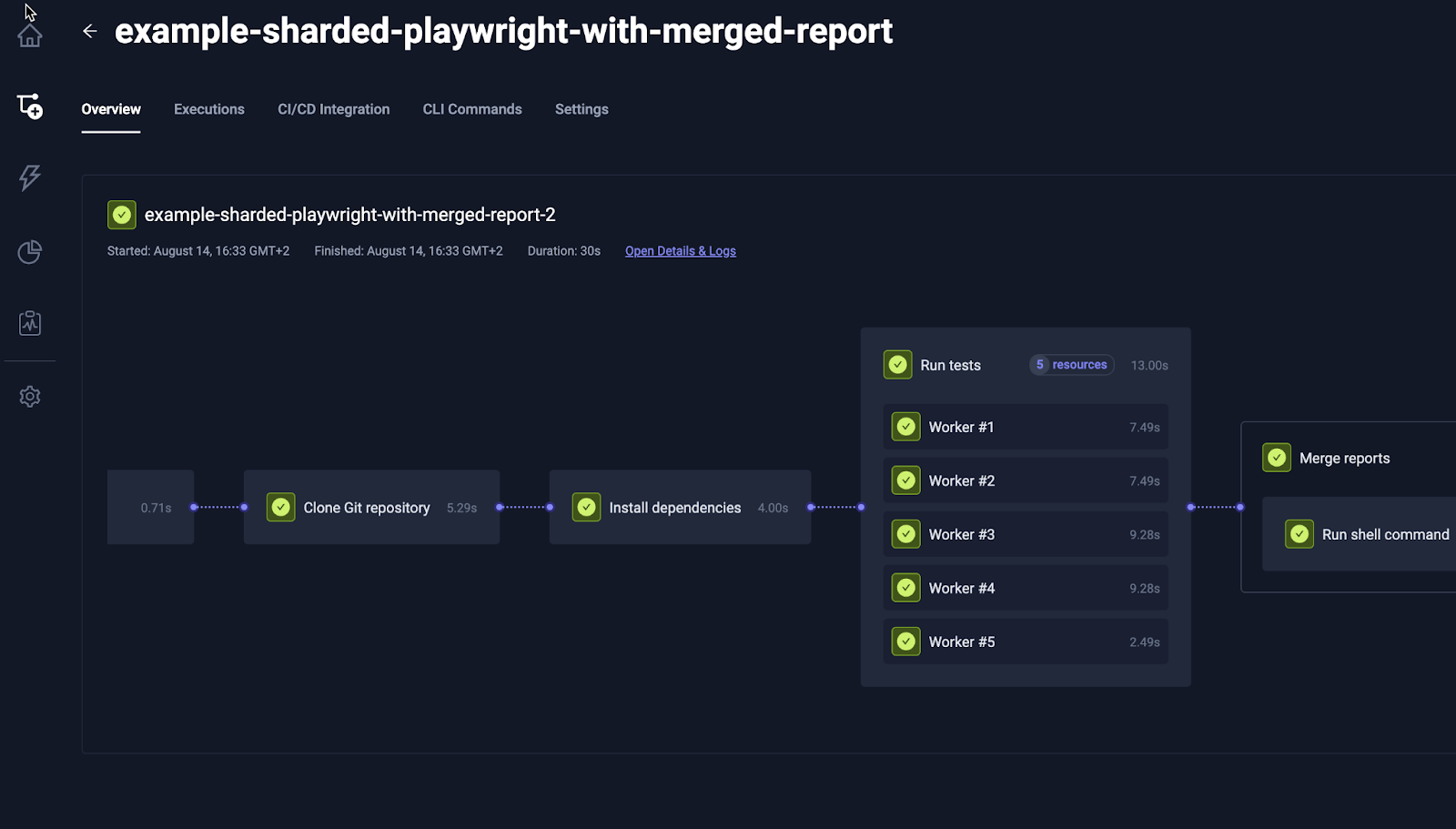
As above, examples for distributed functional testing with these tools are available in the Testkube Documentation.
Composite Workflows for Test Parallelization
The approaches described above with the parallel and shard keywords are meant to be used within a single workflow. If you on the other hand want to combine multiple workflows to run either in sequence or in parallel you can use the execute keyword to orchestrate the execution of any other workflow in any combination required. For example, a master project can coordinate multiple parallel test executions, managing different test suites or projects simultaneously. In such setups, implementing an ATE system helps optimize resource utilization by enabling efficient instrumentation sharing, switch management, and maximizing test infrastructure usage. For example you can:
- Run multiple load-tests in parallel to see how the traffic they simulate affect each other
- Run an E2E or API test in parallel with a load-test to ensure that functionality is maintained under load
- Run a security test in parallel with a distributed load-test to ensure that security is maintained during high load on your applications.
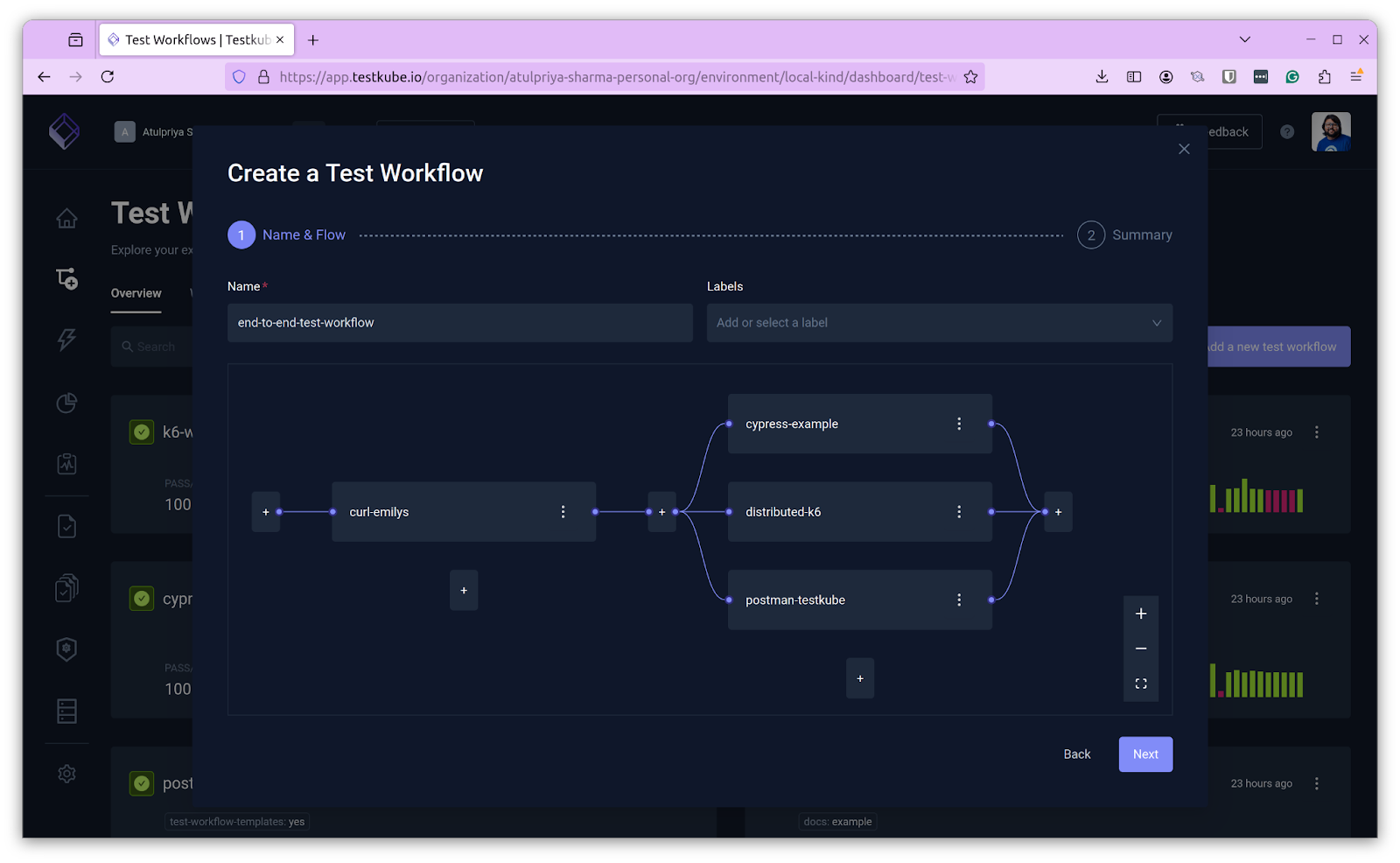
Read more about Composite Testing in Introducing System Testing with Testkube and about the execute keyword in the documentation.
Troubleshooting, Artifacts and Reporting
Testkube automatically captures the log output of any testing tool it runs on all nodes the tools are running on, to help you ensure that tests were executed as desired and debug issues with your executions. Furthermore, Testkube can be configured to capture any artifacts produced by your tests, including aggregate reports, videos, JUnit-reports, etc. When captured, Testkube will make these available via the Dashboard.
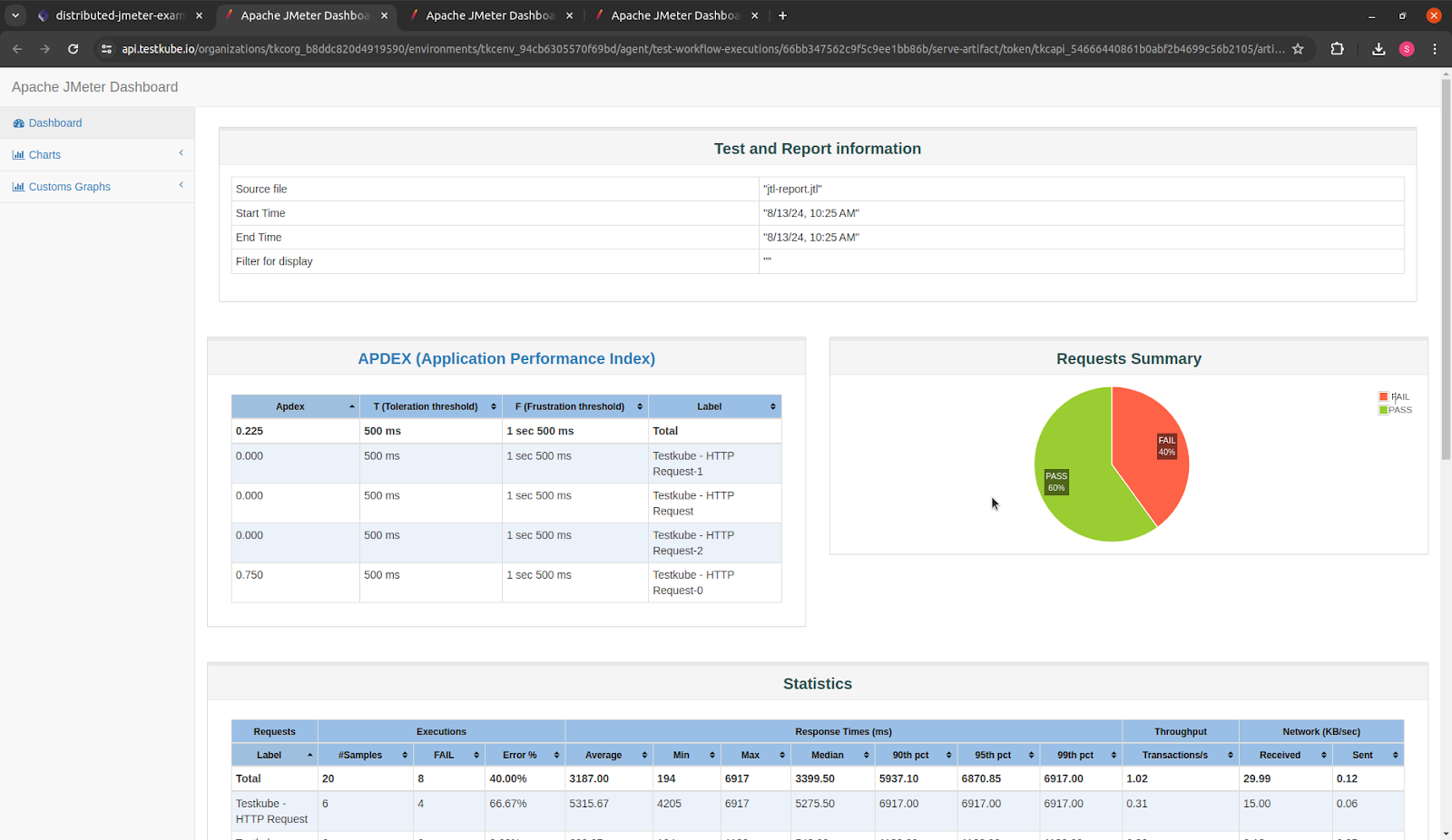
Conclusion
Testing your applications at scale often requires a parallelized execution approach to your testing efforts, be it the parallelization of load-tests to generate massive load, or the parallelization of functional/E2E tests to increase test coverage and improve test execution times.
The recently introduced Test Workflows engine in Testkube allows for parallelization of any testing tool, both load and functional, with additional support for sharding, parameterization and management of dependent services to execute your tests.
Head over to testkube.io/get-started to learn more and give Testkube a try using either our demo environment or your existing tests running in your own infrastructure.


About Testkube
Testkube is a cloud-native continuous testing platform for Kubernetes. It runs tests directly in your clusters, works with any CI/CD system, and supports every testing tool your team uses. By removing CI/CD bottlenecks, Testkube helps teams ship faster with confidence.
Explore the sandbox to see Testkube in action.


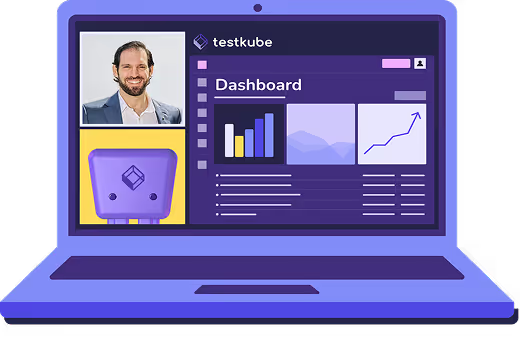
.avif)
